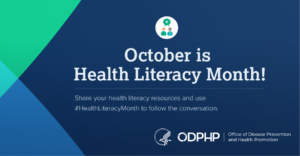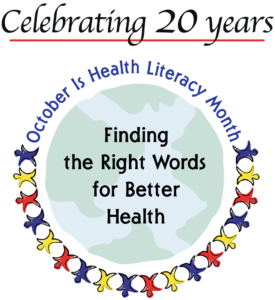During the month of October, Health Literacy Month encourages everyone working to provide easy access to understandable health information. For more than 20 years, October has been recognized as Health Literacy Month. Health Literacy Month is a time of international observance when hospitals, health centers, literacy programs, libraries, social service agencies, businesses, professional associations, government agencies, consumer alliances, and many other groups work collaboratively to integrate and expand the mission of health literacy.
Low health literacy is more prevalent among:
- Older adults
- Minority populations
- Those who have low socioeconomic status
- Medically underserved people”
What Are the Consequences of Low Health Literacy? – The two major areas that are impacted by low health literacy are “economic costs to society and the health-care system, and costs in terms of the human burden of disease” (Institute of Medicine, 2004). There is also considerable psychological suffering created by low health suffering. Within those overarching categories, the results of low health literacy (as measured by reading and numeracy skills) can include:
- Shame and stigma, which can create barriers to health and behavioral health care and to improving low health literacy;
- Reduced knowledge and understanding of a person’s own medical conditions and treatment;
- Reduced knowledge and understanding of health-promoting behaviors and preventive care and services;
- Increased rates of hospitalization and use of emergency services;
- Increased rates of poor health status;
- Entry of sicker patients into healthcare systems;
- Increased health care costs and spending (Institute of Medicine, 2004).
During this time, organizations and individuals promote the importance of understandable health information along with bringing awareness to breaking down the barriers of understanding. According to health experts, there is a large gap between the way health care issues are communicated by professionals, and the ability of the average person to understand them. Most people have limited health literacy… Not just those with limited reading or writing skills. If someone struggles to understand health literacy, statistically, they are more likely to skip important medical tests, have a harder time living with conditions, and visit the emergency room more often. This is why understanding health literacy is so important for everyone.
The good news is, that many health care facilities are trying to improve the way they communicate with patients to make sure everything is clear before the patient leaves. They are doing things like simplifying their written materials, using video and photos to teach patients, and more to help doctors clearly get their message across.
There are a few things you can do to improve your own health literacy individually or as a organization:
1. Improve your communication with health professionals. Make a list of your symptoms before you go in, have questions written down, and take a few notes when your doctor is explaining things to you.
2. Make sure you know who to call with any questions when you leave.
3. Attend health education programs at a library, community center, or anywhere you can find them in your community.
4. Talk to local schools and request that kids are taught about health literacy and education so they are prepared as they get older.
5. Hold a staff training to teach staff to use simple language, short sentences, and explain medical terms. Some useful tools for measuring individual.
6. Update materials for your organization to include similar resources in the primary language for Limited English Proficiency.

